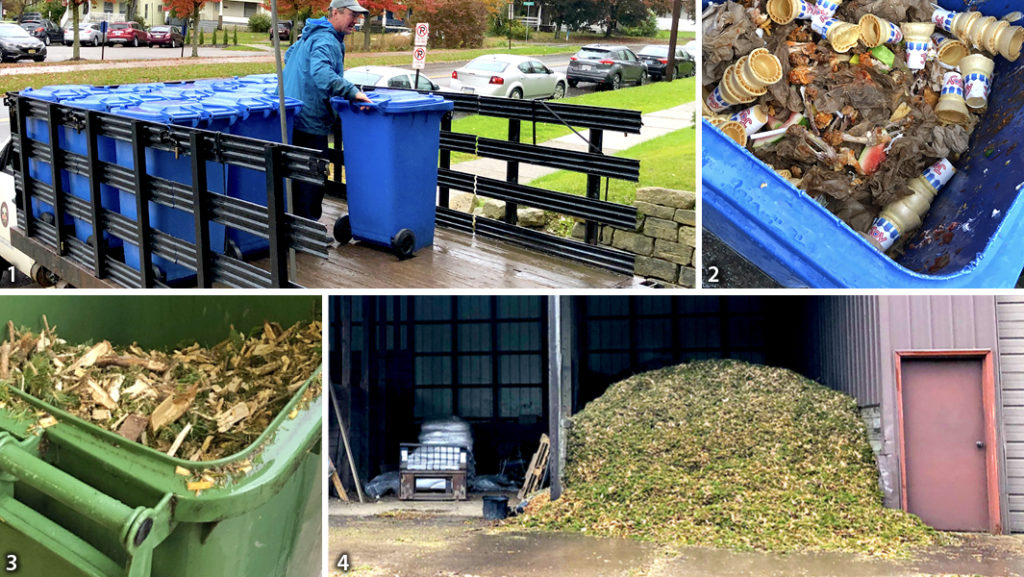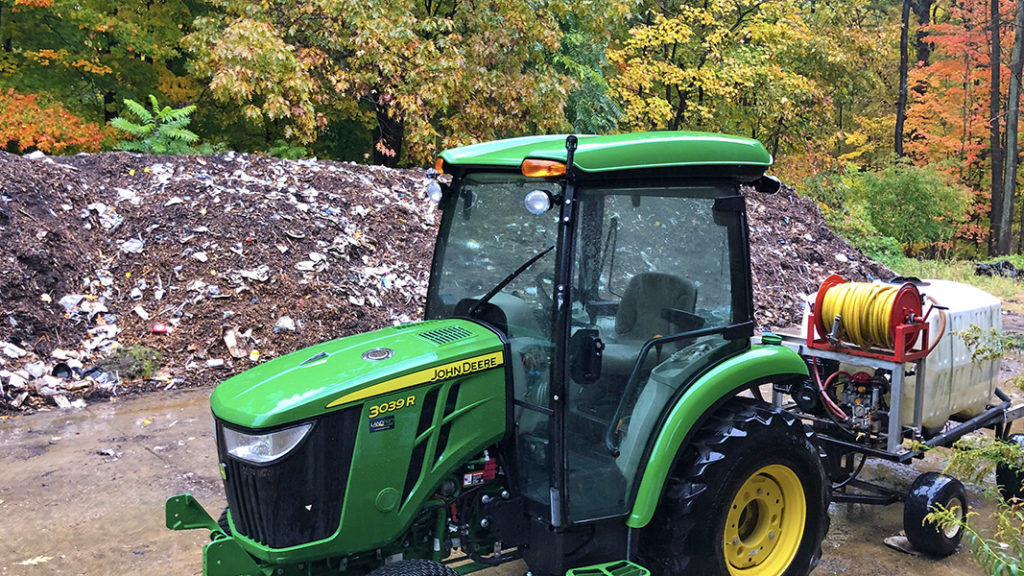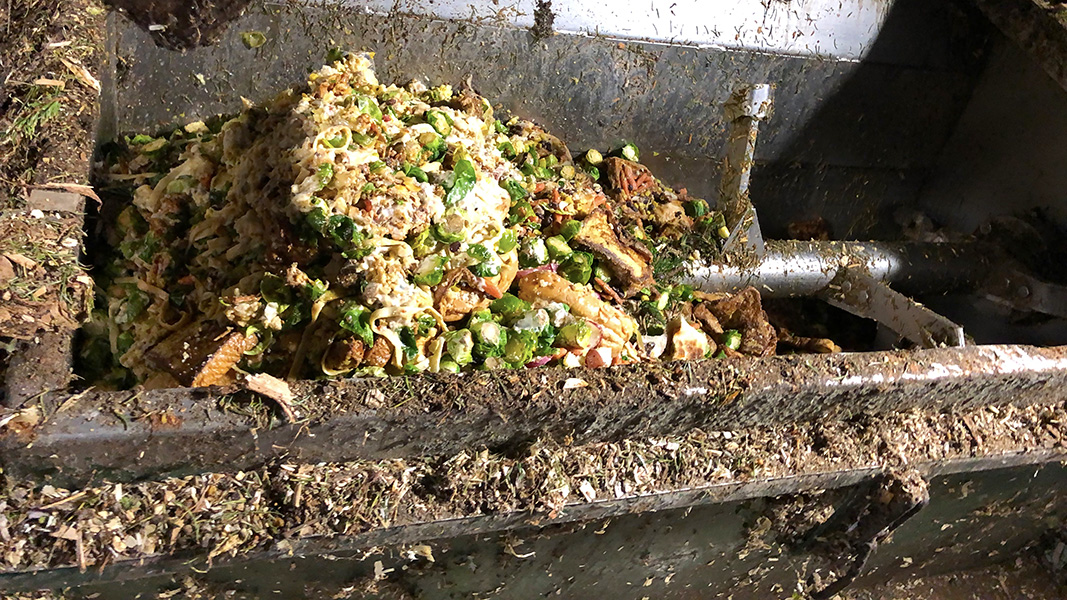Top: Food scraps to be combined with chipped tree trimmings in the in-vessel composting unit’s mixer.
Robert Spencer
Allegheny College in Meadville, Pennsylvania started food scraps composting in 2001, the first higher education institution in the state to do so. Twenty-one years later, the program remains an integral component of sustainability for the campus dining facilities, grounds maintenance, and academics. Since establishing its environmental studies program in the early 1970s, the Department of Environmental Science and Sustainability has grown to be one of the largest departments in terms of students and faculty at the college.
Kelly Boulton, an alumni, was hired as Director of Sustainability in 2008 to coordinate the numerous sustainability programs in recycling, energy conservation, and greenhouse gas reduction. She notes that BioCycle’s 2008 article about the composting program has been provided to numerous colleges who inquire about Allegheny’s integration of composting and sustainability. “Our composting program has been very successful in diverting waste from the landfill, reducing our carbon footprint, and providing organic fertility for our campus lawns and gardens,” says Boulton. “It also results in financial savings and creates opportunities for faculty and students to integrate composting into their classes and research.”
Collection And Composting
The food service contractor, Aramark, diverts both pre and postconsumer food waste, including BPI-certified compostable serving ware and cutlery from two dining halls. The building and grounds staff collect totes of food scraps and haul them to the composting facility. An in-vessel Wright Environmental aerobic composting machine is located inside a building that is set on a remote part of the campus near the athletic fields. The unit is totally enclosed excepting for a compost discharge conveyor that passes through the wall. A biofilter is a permanent part of the unit. Contents in the leachate holding tank can be pumped into the municipal sewer system.

Totes of food scraps are collected from the dining halls (1,2). They are mixed with chipped tree trimmings (3) that are stored in a bunker (4). Photos courtesy of Allegheny College

Filled totes (top) are moved by elevator to the top of the vessel and tipped into a mixer. Blended feedstocks fall onto trays (bottom) that move through the composting unit.
Due to limited storage space at the dining halls, staff collect approximately 500 lbs/day of food scraps 7 days/week. About once a week, laboratory rat bedding is collected, which is added to the food scraps to absorb some of the liquid in the totes. Chipped tree trimmings are dropped off by an electric utility and stored in a bunker under roof. To load material into the vessel, a tote is placed in an elevator that lifts it to a loading door on top of the machine. “It is tipped into a mixer installed at the top of the machine,” explains Jim Mulligan, the composting facility operator. “We combine about 100 lbs of the wood chips and about 130 lbs of food scraps into the mixer, along with soiled paper. The feedstocks are mixed and then the material falls onto one of 16 trays that rotate through the vessel. We repeat that about 5 to 7 times a day to load the collected food scraps into the vessel. A chain drive moves the trays and requires periodic greasing.”
Typical retention time in the vessel is 16 to 18 days. Temperatures reach 130°F to 160°F. “A temperature probe is inserted into a batch at day 10, and typically documents temperatures of 130°F to 140°F on average,” he adds. “The stainless steel vessel is very well built and is exceeding its estimated 20-year life span. Although the trays are not stainless, they also hold up very well.”
Compost is discharged via a conveyor, and drops outside onto a 30-foot by 120-foot concrete pad behind the building. Three cubic yards (cy) of the composted food scraps are mixed with 20 cy of leaves supplied by the Meadville Public Works Department and 5 cy of manure. The pile is turned with a windrow turner. “We amend the compost with the leaves and manure due to the high salinity content of the food scraps,” notes Mulligan. “The compostable service ware disintegrates in the vessel, but some items still require further composting. After additional time in the windrow, which reaches thermophilic temperatures, the products are completely disintegrated.”

Composted food scraps from the vessel are mixed with leaves and manure and further processed in a windrow. The sprayer used to apply compost tea is on trailer in the foreground.
Compost And Compost Tea
Finished compost is screened and stored in a cement bunker and covered with plastic until ready for use on the campus grounds. The material is tested annually.
Boulton and Mulligan both emphasize that a significant benefit of the composting program is providing compost and compost tea for use on campus grounds and gardens. The college has two compost tea brewers, each 150-gallons. A 225-gallon sprayer is used to apply the tea to the lawns and gardens about once per month. “This has reduced use of synthetic fertilizers and helps hold moisture,” says Mulligan. “We also make our own topsoil by mixing 3 cy of soil with 1 cy of compost. For a new lawn at Bentley Hall this year, a prominent historical building, we used 1,500 cy of the blend. We also use the blend for trees, plantings, the campus organic vegetable garden, a base for sod, and repairs to our lawns.” The college also works with local tree nurseries to enhance campus plantings.
Bob Spencer, an Allegheny College alumni, has been a Contributing Editor to BioCycle for over 30 years. He is Executive Director of the Windham Solid Waste Management District in Brattleboro, Vermont.













